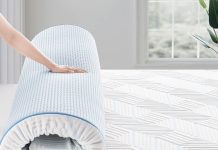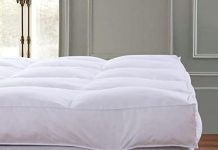As we settle into our cozy beds at night, we often seek that extra layer of comfort that can transform our sleeping experience. That’s where mattress toppers come in! But the big question is, how thick should a mattress topper be? The answer to this seemingly simple question can greatly impact the quality of your sleep and overall comfort. In this article, we’ll explore the factors to consider when determining the ideal thickness for your mattress topper, ensuring you wake up feeling refreshed and rejuvenated each morning. So, let’s dive into the world of mattress toppers and discover the perfect thickness for a restful night’s sleep!
Review contents
Benefits of Using a Mattress Topper
Enhanced Comfort
Using a mattress topper can greatly enhance the overall comfort of your bed. Whether you have a firm mattress that is too hard for your liking, or a mattress that has started to sag over time, a mattress topper can provide an extra layer of cushioning and support. It creates a more plush sleeping surface, allowing you to sink in and experience a luxurious feel that promotes relaxation and a more restful sleep.
Pressure Relief
Another significant benefit of using a mattress topper is the pressure-relieving properties it offers. Many people experience discomfort and pain in pressure points such as the hips, shoulders, and lower back. A mattress topper, particularly one made of memory foam or latex, can help distribute your body weight evenly and reduce pressure on these sensitive areas. This can alleviate discomfort and help you wake up feeling more refreshed and rejuvenated.
Temperature Regulation
Temperature regulation is an important factor to consider when it comes to achieving a good night’s sleep. Some mattress toppers are designed to help regulate body temperature, ensuring that you stay cool and comfortable throughout the night. Materials like latex and gel-infused memory foam have natural cooling properties that dissipate heat, preventing you from feeling hot and sweaty. On the other hand, if you tend to feel colder at night, choosing a mattress topper with down or feather fill can provide extra warmth and coziness.
Factors to Consider
Bed Type
When choosing a mattress topper, consider the type of bed you have. Different bed types require different levels of support and cushioning. For example, if you have a firm mattress, you may benefit from a thicker mattress topper that adds softness and comfort. On the other hand, if you have a soft mattress, a thinner topper may be sufficient to provide the desired level of support.
Body Weight
Body weight is another important factor to consider when selecting a mattress topper. Heavier individuals may require a thicker topper to ensure proper support and pressure relief. Lighter individuals, on the other hand, may find that a thinner topper offers enough cushioning without feeling too soft or sinking in too much.
Sleeping Position
Your preferred sleeping position should also play a role in determining the type and thickness of mattress topper that would best suit your needs. Different sleeping positions require varying levels of support and alignment. For example, side sleepers typically benefit from a thicker topper that can cushion the joints and relieve pressure points. Back sleepers may find a medium-firm topper to be more suitable for maintaining proper spinal alignment. Stomach sleepers, on the other hand, may prefer a thinner topper that provides a firmer surface to prevent excessive sinking of the hips.
Types of Mattress Toppers
Memory Foam
Memory foam mattress toppers are known for their exceptional contouring properties. They conform to your body shape, providing personalized support and pressure relief. Memory foam toppers are available in various thicknesses, catering to different preferences and comfort needs.
Latex
Latex mattress toppers are durable and resilient, offering a natural bounce and responsiveness. They provide both comfort and support, with varying levels of firmness available. Latex toppers are also naturally hypoallergenic and resistant to dust mites, making them an excellent choice for allergy sufferers.
Feather
Feather mattress toppers provide a luxurious and soft sleeping surface. They are lightweight and offer a plush feel, with the feathers providing a gentle cradling effect. Feather toppers are ideal for those who prefer a softer mattress feel and enjoy the sensation of sinking into their bed.
Down
Similar to feather toppers, down mattress toppers offer a soft and fluffy feel. They are made from the fine, fluffy feathers found under the outer feathers of birds. Down toppers provide excellent insulation and are highly breathable, allowing for effective temperature regulation.
Polyester Fill
Polyester fill mattress toppers are a more affordable option compared to natural fillings like feather or down. They offer medium support and cushioning, making them suitable for a range of sleepers. Polyester toppers are hypoallergenic and resistant to dust mites, making them a good choice for those with allergies.
Thickness Options
1-2 inches
Mattress toppers in the 1-2 inch range are the thinnest options available. These toppers provide a minimal amount of cushioning and are best suited for those who only require a slight adjustment to the firmness of their mattress. They can also be a good choice for individuals who prefer a firmer sleeping surface or have a mattress that is already fairly soft.
2-3 inches
Toppers in the 2-3 inch range offer a moderate level of cushioning and support. They strike a balance between providing comfort and maintaining the overall feel of the mattress. These toppers can be suitable for individuals who have a mattress that is too firm or those who want a slightly softer sleeping surface.
3-4 inches
Mattress toppers in the 3-4 inch range offer a substantial amount of cushioning and support. They are ideal for individuals who need extra plushness or who want to transform their firm mattress into a more luxurious sleeping surface. These toppers provide excellent pressure relief and can help alleviate joint and muscle pain.
4+ inches
The thickest mattress toppers, those measuring 4 inches or more, are designed for individuals who need maximum cushioning and support. These toppers are particularly beneficial for heavier individuals or those who suffer from chronic pain. They provide a plush sleeping surface that helps distribute body weight evenly and reduce pressure points.
Choosing the Right Thickness
Personal Preference
One of the most important factors in choosing the right thickness for your mattress topper is personal preference. Consider how much cushioning and support you desire and what feels most comfortable to you. If you prefer a firmer sleeping surface, a thinner topper may be sufficient. For those who enjoy a plush and soft feel, a thicker topper would be more suitable.
Existing Mattress Thickness
Take into account the thickness of your existing mattress when selecting a mattress topper. If you have a mattress that is already very thick, adding a thick topper on top of it may make the bed feel uncomfortably high. On the other hand, if you have a thinner mattress, a thicker topper can compensate for the lack of cushioning and create a more substantial sleeping surface.
How Thickness Affects Sleep
Back and Spine Alignment
The thickness of your mattress topper can have a significant impact on the alignment of your back and spine while you sleep. A mattress topper that is too thin may not provide enough contouring or support, leading to an improper alignment that can result in back pain or discomfort. Conversely, a topper that is too thick may cause excessive sinking and curvature of the spine, leading to poor alignment. It is important to find the right balance in thickness to maintain optimal spinal alignment.
Pressure Points
The cushioning and contouring properties of a mattress topper can help relieve pressure points on the body. A thicker topper, especially one made of memory foam or latex, can provide deeper cushioning and better distribute your body weight, alleviating pressure on areas such as the hips, shoulders, and lower back. Thinner toppers may not offer as much pressure relief, particularly for individuals who have sensitive or problem areas.
Motion Isolation
Thickness can also affect the motion isolation capabilities of a mattress topper. Thicker toppers, especially those made of memory foam, excel in isolating motion and preventing it from transferring across the bed. This can be particularly beneficial for couples who have different sleep schedules or who are easily disturbed by their partner’s movements. Thinner toppers may not absorb motion as effectively, which could result in more disturbance during sleep.
Weight Considerations
Lightweight Sleepers
Lightweight individuals generally require less cushioning and support from their mattress topper. A thinner topper in the 1-2 inch range may be sufficient to provide the desired level of comfort. It is important to find a balance that allows for proper support without excessive sinking, as a thicker topper may feel too soft for a lighter individual.
Average Weight Sleepers
Average weight sleepers can usually choose from a wider range of thickness options, depending on their personal preference and comfort needs. Toppers in the 2-3 inch range are often suitable for maintaining a balanced feel without compromising support. However, individuals who prefer a plusher sleeping surface may opt for a slightly thicker topper.
Heavyweight Sleepers
Heavier individuals benefit from a thicker mattress topper that can provide adequate support and cushioning. Toppers in the 3-4 inch range or thicker are often more suitable for heavyweight sleepers. The extra thickness helps distribute body weight more evenly and helps alleviate pressure on joints and pressure points.
Sleeping Position
Side Sleepers
Side sleepers often experience pressure points around the hips and shoulders due to the body’s natural curvature in this position. A thicker mattress topper, particularly one in the 3-4 inch range, can provide additional cushioning and contouring to relieve pressure on these areas. Side sleepers may find that a thicker topper promotes better spine alignment and reduces the risk of waking up with pain or discomfort.
Back Sleepers
Back sleepers generally require a balance between support and cushioning to maintain proper spinal alignment. A topper in the 2-3 inch range often provides adequate support for back sleepers, as it can conform to the natural curve of the lower back while still maintaining a firmer surface. Too much thickness may cause excessive sinking, while too little may result in inadequate support.
Stomach Sleepers
Stomach sleepers typically require a firmer sleeping surface to prevent excessive sinking of the hips, which can lead to strain on the lower back. A thinner topper, preferably in the 1-2 inch range, can provide sufficient cushioning without compromising the necessary support for proper spine alignment. Stomach sleepers should avoid excessive thickness, as it may cause the hips to sink too deeply.
Combination Sleepers
Combination sleepers who frequently change positions throughout the night may benefit from a medium-thickness topper that strikes a balance between cushioning and support. Toppers in the 2-3 inch range are often suitable for combination sleepers, as they provide enough comfort and contouring without hindering ease of movement or compromising spinal alignment.
Mattress Topper Care
Cleaning and Maintenance
To keep your mattress topper in optimal condition, it is important to follow proper cleaning and maintenance practices. Most mattress toppers come with manufacturer guidelines for cleaning. Generally, it is recommended to spot clean any stains or spills using a mild detergent and warm water. Avoid saturating the topper and allow it to air dry fully before placing it back on your bed. Regularly airing out and fluffing the topper can help maintain its freshness and ensure proper ventilation.
Flipping and Rotating
Depending on the type of mattress topper you have, flipping or rotating it periodically may be necessary to prevent uneven wear. Some toppers, such as memory foam or latex, may not require flipping but can benefit from being rotated every few months. This can help prolong the lifespan of your topper and ensure even compression across the surface.
Conclusion
Using a mattress topper can greatly enhance the comfort and support of your bed, leading to improved sleep quality. By considering factors such as bed type, body weight, and sleeping position, you can select the right type and thickness of mattress topper to meet your specific needs. Whether you opt for a memory foam, latex, feather, down, or polyester fill topper, each offers unique benefits in terms of cushioning and support. Regular care and maintenance, such as proper cleaning and occasional flipping or rotating, can help prolong the lifespan of your mattress topper. With the right mattress topper, you can enjoy a more comfortable and restful sleep experience.
























